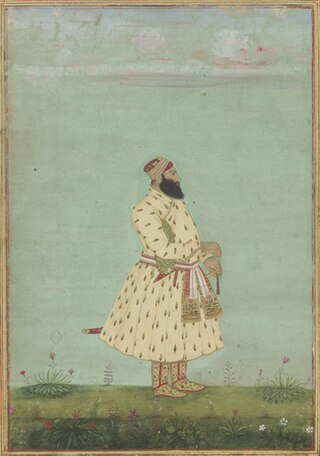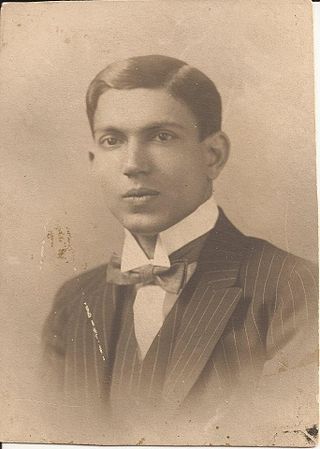
Jayaprakash Narayan Srivastava,also known as JP and Lok Nayak,was an Indian politician,theorist and independence activist. He is mainly remembered for leading the mid-1970s opposition against Prime Minister Indira Gandhi and calling for her overthrow in a "total revolution". In 1999,Narayan was posthumously awarded the Bharat Ratna,India's highest civilian award,in recognition of his social service. His other awards include the Magsaysay award for public service in 1965.

Giani Zail Singh was an Indian politician from Punjab who served as the seventh president of India from 1982 to 1987 and 9th Chief Minister of Punjab. He was the first Sikh to become president.

The Quit India Movement was a movement launched at the Bombay session of the All India Congress Committee by Mahatma Gandhi on 8 August 1942,during World War II,demanding an end to British rule in India.

Khushwant SinghFKC was an Indian author,lawyer,diplomat,journalist and politician. His experience in the 1947 Partition of India inspired him to write Train to Pakistan in 1956,which became his most well-known novel.

Madhavrao Jiwajirao Scindia was an Indian politician and minister in the Government of India. He was a member of the Indian National Congress. He was viewed as a potential future prime ministerial candidate before the 1999 Lok Sabha elections in the aftermath of the controversy over Sonia Gandhi's foreign origin.

Maharaja Suraj Mal,simply known as Suraj Mal,was a ruler of Bharatpur State in the present-day state of Rajasthan. Under him,Bharatpur State,a tributary of the House of Scindia,covered the present-day districts of Agra,Alwar,Aligarh,Bharatpur,Dholpur,Etawa,Hathras,Mainpuri,Meerut,Ghaziabad,Mathura,and Rohtak,Sonipat,Jhajjar,Nuh,Palwal,Faridabad,Kasganj,Mainpuri,Firozabad,Bulandshahr.

Wazir-ul-Mamalik-e-Hindustan Asaf Jah Jamat-ul-Mulk Shuja-ud-Daula Nawab Abul Mansur Khan Bahadur Safdar Jang Sipah Salar,better known as Safdar Jang,was the second Nawab of Kingdom of Awadh succeeding Saadat Ali Khan I in the year 1739. All future Nawabs of Awadh were patriarchal descendants of Safdar Jang. He was a major political figure at the imperial Mughal court during the declining years of the Mughal Empire.

Asaf Ali was an Indian independence activist and noted lawyer. He was the first Indian Ambassador to the United States. He also served as the Governor of Odisha.

Aruna Asaf Ali was an Indian educator,political activist,and publisher. An active participant in the Indian independence movement,she is widely remembered for hoisting the Indian National flag at the Gowalia Tank maidan,Bombay during the Quit India Movement in 1942. Post-independence,she remained active in politics,becoming Delhi's first Mayor.

Mahadaji Shinde,later known as Mahadji Scindia or Madhava Rao Scindia,was a Maratha statesman and general who served as the Maharaja of Gwalior from 1768 to 1794. He was the fifth and the youngest son of Ranoji Rao Scindia,the founder of the Scindia dynasty. He is reputed for having restored the Maratha rule over North India and for modernizing his army.
Honorary Magistrate,Sardar Bahadur,Sir Sobha Singh,M.L.C.,M.P. was an Indian civil contractor,prominent builder and real estate developer of the modern day Delhi.
Purnima Banerjee was an Indian anti-colonial nationalist and a member of the Constituent Assembly of India from 1946 to 1950.

Sir Walter Sykes GeorgeC.B.E. was an English architect active in India during the first half of the 20th century,most known for being part of the team of architects who designed New Delhi,the new capital of India,from 1911-1931.

Gurmukh Singh Musafir was an Indian politician and Punjabi language writer. He was the 5th Chief Minister of Punjab from 1 November 1966 to 8 March 1967.

Yashwant Rao Holkar (1776–1811) also known as Jaswantrao Holkar belonging to the Holkar dynasty of the Maratha Confederacy was the Maharaja of the Indore. He was a gifted military leader and educated in accountancy as well as literate in Persian,Marathi and Urdu.
Governor Ujjal Singh was an Indian politician who was a participant in the First Round Table Conference,opened officially by King George V on 12 November 1930. Ujjal Singh served as the Finance Minister of Punjab,Governor of Punjab,followed by acting Governor of Tamil Nadu. Prior to this he was one of Pre-Partition Punjab's largest landowners,owning thousands of acres in Hadali,Jaranwala,Mian Channu,Lyallpur,Montgomery,Sargodha and other areas.
Guru Radha Kishan (1925-1996) was an Indian Independence activist and Communist politician.
Sayed Muzaffar Hussain Burney was a civil servant,governor of the states of Tripura,Nagaland,Haryana and Himachal Pradesh and a chairman of the National Minorities Commission.
The construction ofNew Delhi refers to the development of Delhi into the capital of the British Raj,and creation of New Delhi in a mass-scale real estate development project before the Independence of India. Before the project,Delhi was known of as a large slum due to the unplanned settlements of Old Delhi or Shahjahanabad. The British proposed the project after the Delhi Durbar in 1911,although due to World War I,it was delayed by around ten years till the 1920s. The New Delhi Project continued till the 1940s.













